Jane Austen | |
|---|---|
 A watercolour and pencil sketch of Austen, believed to have been drawn from life by her sister Cassandra (c. 1810) | |
| Born | 16 December 1775 Steventon Rectory, Hampshire |
| Died | 18 July 1817 (aged 41) Winchester, Hampshire |
| Resting place | Winchester Cathedral, Hampshire |
| Nationality | English |
| Period | 1787 to 1809–1811 |
| Genres | Comedy of Manners, Romance |
| Signature | |
The reception history of Jane Austen follows a path from modest fame to wild popularity. Jane Austen (1775–1817), the author of such works as Pride and Prejudice (1813) and Emma (1815), has become one of the best-known and most widely read novelists in the English language.[1] Her novels are the subject of intense scholarly study and the centre of a diverse fan culture.
During her lifetime, Austen's novels brought her little personal fame. Like many women writers, she chose to publish anonymously, but her authorship was an open secret. At the time they were published, Austen's works were considered fashionable, but received only a few reviews, albeit positive. By the mid-19th century, her novels were admired by members of the literary elite who viewed their appreciation of her works as a mark of cultivation, but they were also being recommended in the popular education movement and on school reading lists as early as 1838. The first illustrated edition of her works appeared in 1833, in Richard Bentley's Standard Novels series, which put her titles before thousands of readers across the Victorian period.[2]
The publication in 1870 of her nephew's Memoir of Jane Austen introduced her to a wider public as an appealing personality—dear aunt Jane—and her works were republished in popular editions. By the start of the 20th century, competing groups had sprung up—some to worship her and some to defend her from the "teeming masses"—but all claiming to be the true Janeites, or those who properly appreciated her. The "teeming masses", meanwhile, were creating their own ways of honouring Austen, including in amateur theatricals in drawing rooms, schools, and community groups.[3]
In 1923, the publisher and scholar R. W. Chapman prepared a carefully edited collection of her works, which some have claimed is the first serious scholarly treatment given to any British novelist. By mid-century, Austen was widely accepted within academia as a great English novelist. The second half of the 20th century saw a proliferation of Austen scholarship, which explored numerous aspects of her works: artistic, ideological, and historical. With the growing professionalisation of university English departments in the second half of the 20th century, criticism of Austen became more theoretical and specialized, as did literary studies in general. As a result, commentary on Austen sometimes seemed to imagine itself as divided into high culture and popular culture branches. In the mid- to late 20th century, fans founded Jane Austen societies and clubs to celebrate the author, her time, and her works. As of the early 21st century, Austen fandom supports an industry of printed sequels and prequels as well as television and film adaptations, which started with the 1940 film Pride and Prejudice and evolved to include productions such as the 2004 Bollywood-style film Bride and Prejudice.
On 5 November 2019 BBC News included Pride and Prejudice on its list of the 100 most influential novels.[4]
- ^ Clark, Robert. "Jane Austen". The Literary Encyclopedia (subscription only). 8 January 2001. Retrieved 24 August 2008.
- ^ Looser, Devoney. The Making of Jane Austen. 19–22.
- ^ Looser, Devoney. The Making of Jane Austen. 83–97.
- ^ Cite error: The named reference
Bbc2019-11-05was invoked but never defined (see the help page).